“What is it you do to practice that is analogous to how a pianist practices scales?”
— Tyler Cowen (professor, blogger, podcaster, and co-author of Talent)
Since reading Talent, I haven’t been able to get this question out of my head.
In a subsequent podcast with NBA reporter Ethan Sherwood Strauss, Cowen underscored the importance of continuous improvement through practice:
Steph Curry, beside all his athletic abilities, simply that he figured out how to practice so effectively, is in a way his most remarkable talent.
Before we dive into Steph’s practice routine, let’s dissect what makes him so special. Sure, his hand-eye coordination is legendary along with his depth perception and court vision. But unlike other all-timers, he doesn’t overpower the opponent. He can shoot from anywhere at anytime and beats you with dazzling finesse. He invokes constant FOMO forcing even the most casual fan to remain glued to her TV. Steph is a magician and has made us numb to the unfathomable.
Steph has surpassed other world class shooters due to his ability to consistently create space despite being the focal point of the defense. Tracing the dots all the way back to his youth, Curry recalls, “I was a good shooter, but I got my shot blocked a lot.” Our shortcomings often help develop our greatest strengths.
Here is how Steph keeps taller defenders out of reach:
I. Extending range while maintaining accuracy
Take a look at Steph’s shot chart compared to Steve Nash and Ray Allen in their prime. Steph has changed the entire shape of the game.

Curry was known for his range before entering the NBA but 2015 is the year Steph went to unchartered territory. It was Halloween, their third game of the season, and Curry erupted for 53 points including a 31 foot three-pointer over Anthony Davis with 16 seconds left on the shot clock. After the game Steph tried to maintain his invisibility cloak by calling it a dumb shot. But now it’s clear he spent that entire summer practicing “dumb” shots.
II. Ability to drive to the rim and finish through traffic
Given his range, defenders are forced to crowd Steph 30+ feet from the basket. But Curry can leverage his handle, quickness, and deceptive strength to blow right past them creating a layup or an open look for a teammate.
You can see this visually from the cluster of dots in the paint on his shot chart. Steph appears to have been born in an analytics lab.
III. Fundamentals
Growing up, Steph compensated for his lack of size by perfecting his shooting motion. His mechanics are compact and efficient. This helps increase consistency and it’s easier to improvise with less moving parts. He has a high release point and shoots early in his jump making the shot very difficult to block. Unlike traditional jump shooters, his minimal lift helps keep his legs fresh throughout the game.
And Curry is one of the best conditioned athletes on the planet allowing him to keep relentless pressure on the defense and eek out a few extra open shots each game. With his skillset, Steph could lean on endless pick and rolls like Trae Young. Instead he took a page out of the Reggie Miller playbook and never stops moving.
“We’re talking about practice…”
— Allen Iverson
So let’s get back to the original topic. How does Steph Curry practice?
It starts with selecting a great trainer. Whether you’re a professional athlete or learning a new hobby, far too many people ignore this skill. Just like dating, you need to experiment with various personalities and approaches to find your match. Steph was introduced to his current trainer, Brandon Payne, in late 2011 and recognized the fit right away. He recalls, “We created a vision for where I wanted to be in terms of ballhandling, footwork, balance and, of course, accountability.”
Payne’s job is easier because Steph is obsessed with improvement and willing to try new things. As for the workouts, everything is choreographed with intent and focus.
Curry uses innovative methods to improve decision making and reaction time in pressure situations. Payne refers to this as neurocognitive efficiency and the goal is to overload or deprive his senses to be able to excel in chaotic environments. Sessions will often include strobe goggles, tennis balls, resistance bands, paddles, and sensory deprivation chambers.
To keep the workouts intense, Payne inserts conditioning and competition into each drill. He explains, “Everything we do is against time and score. If you beat the number and you don’t beat the time, you still lose.”
One example is the Full-Court Star, outlined below, where Steph had to make at least eight of 10 shots in 55 seconds.

Warriors teammate Draymond Green noted, “He has to sprint full court just to get one shot up... He works unlike many people that I’ve seen.”
Perhaps most impressive, Warriors assistant coach Bruce Fraser observed, “If he doesn’t get it, he’ll usually do it again. That makes it twice as hard.”
The only athlete who has inspired me more than Steph Curry over the past five years is field hockey sensation Erin Matson.
Country singer and UNC fan Eric Church captured her dominance, “I don’t have to understand the rules to know she’s the GOAT.”
Having followed Matson throughout her Carolina career, it’s impossible to ignore the Steph Curry parallels. She was the youngest and smallest girl on nearly all her youth teams. She is obsessed with improving and does things with the ball that seem impossible. She’s a ruthless competitor and plays with a swagger and joy that is contagious. And she doesn’t shy away from greatness but somehow always remains grounded off the field.

In response to Tyler Cowen’s interview question, I’m confident Erin’s version of scales would be pulls. It may be the most basic drill in the sport but it’s also the building block to more advanced maneuvers like aeriel dribbling and reverse chips. The clip above shows how three consecutive pulls allowed Erin to weave between defenders like they were stationary cones.

The concept of deliberate and efficient practice is well-established in music and athletics. It’s much less obvious in the corporate world.
As an investor, how can I replicate Steph Curry’s shock training techniques to improve decision making in chaotic market environments? And what type of pulls can I do each day to improve as a communicator and storyteller?
In all ambitious pursuits, improvement needs to become an obsession.







I'm an engineer, and I sit at my computer all day. Here's what I do that's broadly applicable:
-Consistently try to learn the keyboard shortcuts of whatever software I'm using. Includes Windows itself; navigating between tabs using things like alt+tab really speeds things up.
-Constantly changing software settings when I find something I dislike.
I'm curious what else applies broadly for white collar work.
For activities like investing where "success" may not be easily defined, having a repeatable process is essential. When evaluating stocks, I follow the same process every time. First, I put the company through a scorecard. This reminds me of the attributes I value most highly in companies and allows me to identify which attributes are most correlated with future gains. If conservatively arbitrary, quantitative thresholds are met in the scorecard process, I value the company relative to profit. If not met, I value the company relative to Tangible Book. So, I have two strategies/valuation methods to track as well as the correlations from the scorecard. It's repeatable, unemotional, and easy to track. Success and failure can be measured relative to the strategies and attributes, rather than attaching narratives to success or failure. I input data, my spreadsheet tells me what to do, and market volatility/chaos (assuming diversification among stocks and long enough holding period) simply heightens returns .